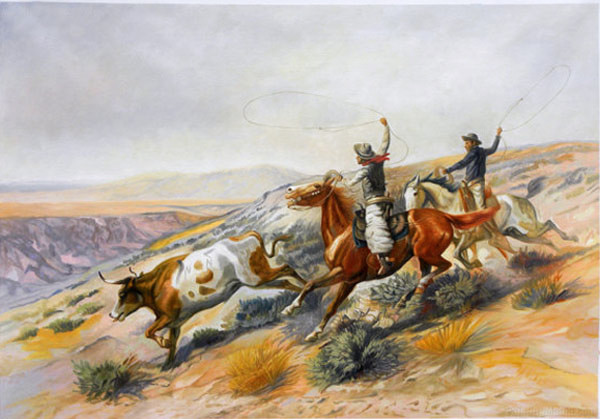
N bar N Buckeroo On the Big Dry.
In the above, note the N - N, Brand on the side of the cow. Russell
frequently put a brand on horses and cows in his paintings.
C. M. Russell while working on the N bar N depicted the life of the cowboys and the dangers similar to those Billy Rutledge faced.
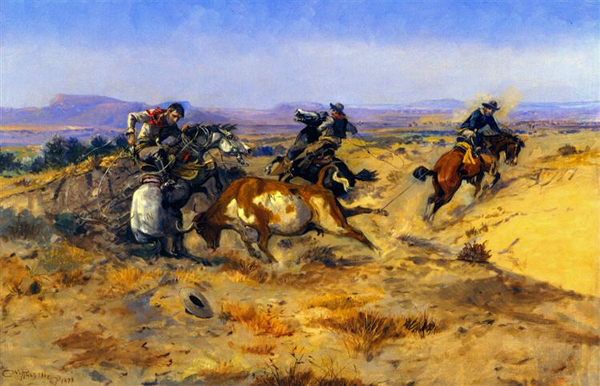
When Cowboys Get in Trouble, 1905.
Again, note the N - N, Brand on the side of the cow.
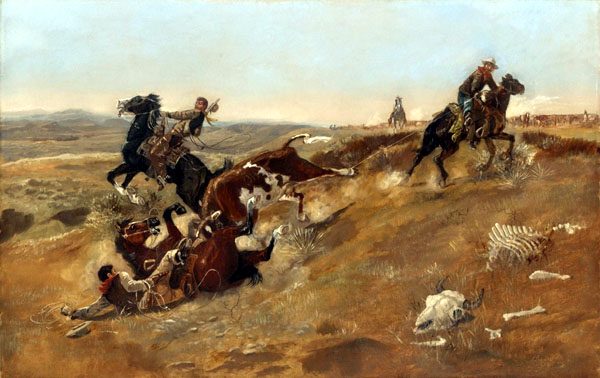
Cowpunching Sometimes Spells Trouble.
The bovine is branded with the O H brand of Pruitt & Phelps.
Russell was working on the "O H" during the winter of 1886-1887
when he sketched his "Waiting for a Chinook" which led to his later career as an artist.
William G. Preuitt was the longtime
secretary-treasuer of the Montana Stock Growers' Association. His partner was Jesse Phelps.
The O H was located on the
south side of Judith Basin, a mile east of Utica. Utica has achieved lasting fame for
Russell's 1907 "A Quiet Day in Utica."

"A Quiet Day In Utica," C. M. Russell, 1907. The painting was originally called
"Tinning a Dog."
Russell depicted himself in the painting, standing
near the store's owner Charles Lehman. By the time of the painting,
the store was closed.
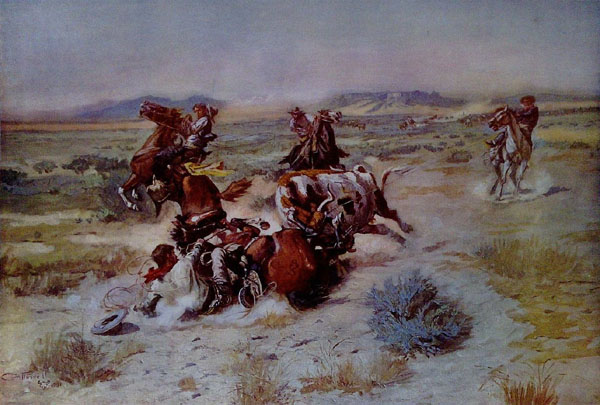
The Strenious Life.
The roped animal bears a brand of Clay & Forrest of Chicago, see below.
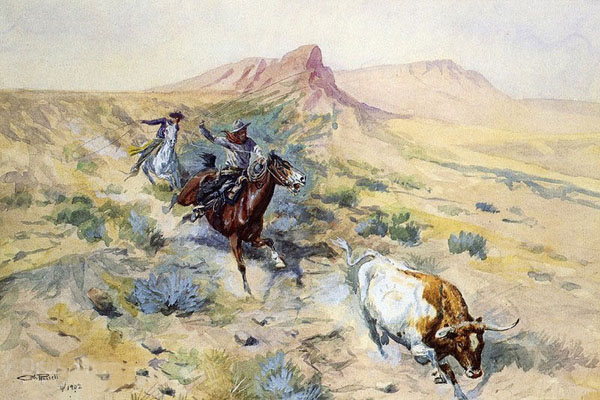
The Herd Quitter, 1902.
The brand is that of M. Chandler from Mussellshell on the edge of the Big Dry, see below.
  Left, Brand for M. Chandler; Right, Brands for Clay & Forest, both from 1899 Montana
Montana Stock Growers' Association Brand Book.
In the Big Dry, the Little Dry, Judith Basin, and elsewhere in the West, the sheep came, and then came the Honyockers. fencing put an end to free range and
"honeyhockers" lured by professorial claims that the climate had changed and that the success of dry farming was guaranteed all put to an end to the great ranches.
Dave Evans, who ranched near the Belle Fourche was quoted by the Denver Post, December 6, 1931:
Left, Brand for M. Chandler; Right, Brands for Clay & Forest, both from 1899 Montana
Montana Stock Growers' Association Brand Book.
In the Big Dry, the Little Dry, Judith Basin, and elsewhere in the West, the sheep came, and then came the Honyockers. fencing put an end to free range and
"honeyhockers" lured by professorial claims that the climate had changed and that the success of dry farming was guaranteed all put to an end to the great ranches.
Dave Evans, who ranched near the Belle Fourche was quoted by the Denver Post, December 6, 1931:
One by one the big outfits, VVV, Hash Knife, the Turkey Track, CY, 101, D-T, and myriad others were reduced to non-enities. In a few years where
previously 20,000 head had been run, 1,000 were grazing on a small ranch. Fences took the place of
watershed for boundaries, and towns sprang up where only sagebrush had held a lonely vigil.
So the old range slipped from us. See Hall, Bert L: "Roundup Years, Old Muddy to Black Hills" p. 91.
By 1899, the N bar N had been sold. In 1906 the Phillips Land & Cattle Co. was taken over by
Swift & Co. When William Hornaday and L. A. Huffman visited the Big Dry, the old Phillips ranch house was in
ruins.
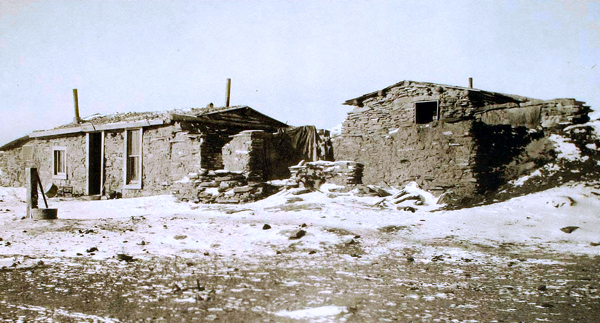
Ruins of the old Phillips' LU bar in the Big Dry. Image by L.A. Huffman.
One old wolfer held on, collecting the bounties offered by Government for each Wolf.
In 1905, a blizzard put the icing on ranching. In the 1898 roundup up on the
Cheyenne, the L7 and Flying V had three wagons. Others contributed wagons for a total of at least 13 wagons.

C Y cowboys loading for the 1902 Spring Roundup, Camp Cook, South Dakota.
Left to Right: No. 6, Lee Devine, wagon boss; No. 7, Powder River Jim;
No. 5, Len Meredith; No. 4 "Scout;" No. 3, Ed Burnett, the "Candy Kid;" No. 2, Paul G. Ames; and No. 1, Dr. Albert Scherrell, the town physician.
The roundup of 1902 along the Cheyenne was
the last big roundup in the western Dakotas. The necessity for the rounduup was decreed by the Federal Government because of the number of cattle that had drifted onto the
Pine Ridge and Rosebud Reservations. The Government collected a dollar a head.
Music this page: "Oh, Bury Me Not on the Lone Prairie" as sung by Carl T. Sprague for
the Victor Talking Machine Co., 1926.
Carl T. Sprague (1895-1979) recorded for only four years, 1925-1919, although in later years he appeared in some
festivals. He is sometimes referred to as the "original singing cowboy. He was an Aggie.
Next Page, Roundups continued.
|